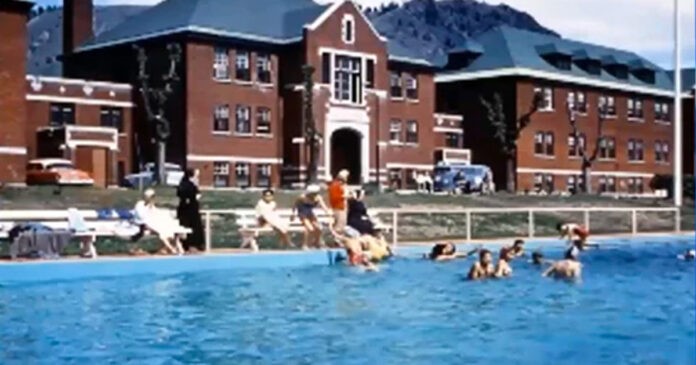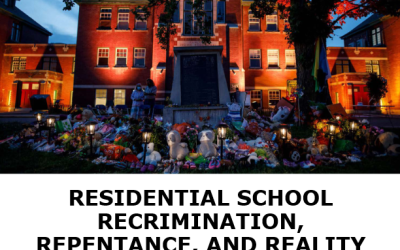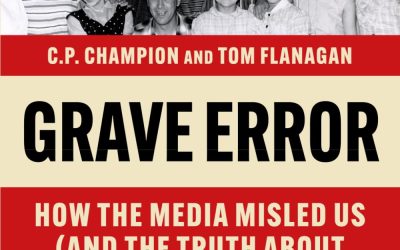Punching Holes In A Story That Doesn’t Hold Water
Although many Canadians are finally beginning to doubt the narrative fed to them over the course of a year of grim media reportage of “unmarked graves” and missing and murdered Indigenous children, there are still those who stubbornly deny that there are any problems with this official narrative.
I wrote earlier in The Turn about the shock and emotional distress felt by Canadians after the 2021 ‘discovery of unmarked graves’ in Canada:
“Many people on social media, some of whom already believed the country was systemically racist, used the sensational headlines as an opportunity to declare it undeniable proof of Canada’s murderous genocidal history. Others said it demonstrates the evil white supremacist colonial underpinnings of the nation. While others were sorrowful, apologetic, insisting the tragic events reinforce the importance of the Truth & Reconciliation work ahead of us.”
If all the guilt and sadness and loss of pride and faith in Canada and its history was based on false assumptions made by a media eager to indulge in sensationalism and disparagement of the West, then the captains of Canada’s legacy media industry owe Canadians an explanation and an apology, and Canadians would be better off ignoring the legacy establishments and assume that narrative-spinning, not truth-seeking, is their business.
When I interviewed retired Manitoba Provincial Court Judge Brian Giesbrecht earlier this month for a series of essays on Canada’s Indigenous and substance abuse, he mentioned an article written decades ago by journalist Patrick Donnelly, and commented that “the horror seems to increase the further removed one is to actual attendance. Donnelly reports that he did not have trouble in the 1990s finding actual attendees of IRS, who have positive things to say about the schools. However, the grandchildren and great grandchildren – who never went to the schools, and often have never spoken to relatives who did – use terms like horror, and atrocity of evil.”
Could this explain why the drama and controversy, in defiance of the Truth & Reconciliation Commission’s declared aspirations for reconciliation, appears to increase in rancour as time goes by? To liken this phenomenon to the rise of urban legends is not an idle comparison. Urban myths become more outrageously exaggerated with each successive generation that takes them up. A legitimate process of truth and reconciliation would do the opposite.
Patrick Donnelly’s Scapegoating the Indian residential schools was written in 1998, and it is telling that back then journalists like Donnelly seemed unafraid to challenge the narrative. In the opening paragraph Donnelly forthrightly states that, “In the week following the Chretien government’s apology to natives for residential schools, news media characterized the historic institutions as “brutal,” “miserable,” “genocidal” and “horrendous.” They were repeating vaguely recounted and unchallenged testimony to a royal commission which concluded that the poorly funded and allegedly abusive schools bear large responsibility for the woeful present plight of many Indians. In none of the media coverage was the possibility raised that the schools were on the whole beneficial and widely supported by the Indians who attended them and voluntarily sent their children to them. Nor was the possibility admitted that the Indian leaders who now revile the schools might be motivated by the prospect of federal compensation.”
Judge Giesbrecht commented that, “Donnelly had no trouble finding former students who spoke positively about their experiences. I had the same experience around that time. Then it became all about politics and money, and suddenly everything about residential schools was horrible”.
Both Judge Giesbrecht and former tenured professor at Mount Royal University, Frances Widdowson, believe that the transfer of billions of dollars for wrongs long since past and the funding for ground penetrating radar (GPR) searches for rumored clandestine burials will do little to address the problems currently facing Canada’s Indigenous peoples.
How did Canada get to this point? What might be considered the “ground zero” event that set the stage for the wildly distorted Indian residential school narrative was Barbara Frum’s 1990 interview on CBC Television with Phil Fontaine in which Fontaine made shocking allegations of widespread sexual abuse at the residential school he attended as a child, abuse which from the context appears to have been student-on-student abuse, although Frum failed to ask the follow-up question which would have elicited that information.
Commenting on that interview, Judge Giesbrecht and Tom Flanagan wrote in the Dorchester Review:
Since that interview, preposterous stories have taken hold and become deeply-rooted in First Nations communities — stories of murders and clandestine burials on a large scale, of babies thrown into furnaces, of children imprisoned in underground chambers and cisterns, hanged in barns, and shocked in electric chairs,[5] with the result that $321 million dollars of federal government funding has been committed to searching for unmarked graves all over the country, and helping surivors heal from their trauma.[6]
There is no documentary evidence to support these stories. There is no record, for example, of a single student being murdered at a residential school —never mind thousands — in the 113-year history of residential schools. Nor — and this is key — are there any records of indigenous parents claiming that their children went to residential schools “never to be seen again,” as claimed by Truth and Reconciliation Commissioner Marie Wilson.[7]
There is a growing body of evidence and opinion differing from the a priori assumptions of the Canadian media’s “narrative truth”, but predictably those who wish to suppress and deny the accumulating body of evidence unfriendly to the agenda of the Aboriginal industry show no inclination to engage with this evidence, but instead, in a clever move, have co-opted the term ‘denier’ and have weaponized it against those whose research is poking holes in the official media narrative.
Niigaan Sinclair of the University of Manitoba, for example, failed to address any of the evidence in a recent National Post op-ed in which Terry Glavin questioned the veracity of the media’s unmarked graves narrative. Instead, Sinclair took to Twitter where he derided it contemptuously as a “steaming pile of misinformation,” and right on cue, accused Glavin of “denialism.”
In a column published in the Winnipeg Free Press on May 31, 2022, Sinclair went further, claiming that denial is a Canadian addiction. Tellingly, however, Sinclair admitted that “The truth is: the full story regarding unmarked graves of residential school children may never be known”. If that is the case, then exactly why is it that Terry Glavin and other columnists and academics are told they are ‘denialists’ when in fact they are digging for evidence and raising questions about a scenario even Niigaan Sinclair admits the full story will never be known?
It seems hardcore activists have little to offer beyond profanity when confronted with challenges to the current narrative. Ian Mosby, self-described as a “settler historian of food, health and colonialism in Canada,” responded to a recent New York Post article which also cast doubt on the unmarked graves narrative by angrily tweeting, “F**k you, @nypost.” Activist-journalist Brandi Morin exclaimed, “Wow @nypost Is seriously publishing this BS??!.. They ARE unmarked graves, yes it’s genocide!! This is friggen disgusting that this was published!!”
They sound genuinely angry, and no doubt are, but that doesn’t absolve them from the task of explaining why Canadians should believe the sensational clandestine burial claims. Until they do, until we get to the bottom of this unmarked graves fiasco, they should expect a lot more questions.
James Pew is an independent writer, father and entrepreneur.



